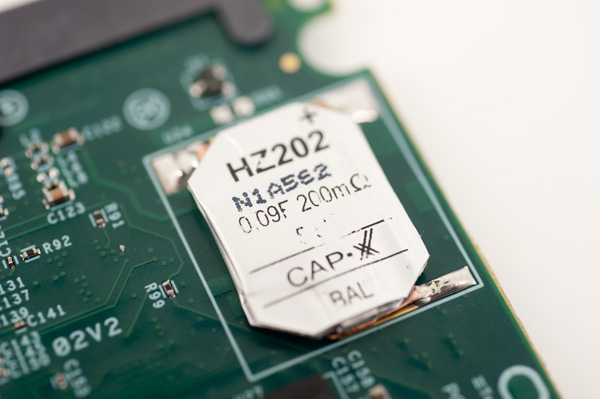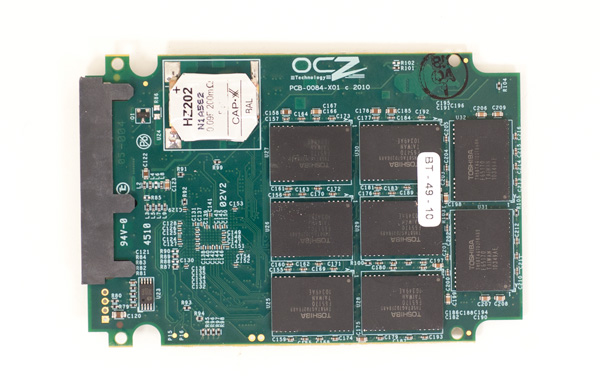OCZ Vertex 3 Pro Preview: The First SF-2500 SSD
by Anand Lal Shimpi on February 17, 2011 3:01 AM ESTToday: Toshiba 32nm Toggle NAND, Tomorrow: IMFT 25nm
The Vertex 3 Pro sample I received is a drive rated at 200GB with 256GB of NAND on-board. The SF-2682 controller is still an 8-channel architecture and OCZ populates all 8 channels with a total of 16 NAND devices. OCZ selected Toshiba 32nm Toggle Mode MLC NAND for these early Vertex 3 Pro samples however final shipping versions might transition to IMFT 25nm. The consumer version (Vertex 3) will use IMFT 25nm for sure.
Each of the 16 NAND devices on board is 16GB in size. Each package is made up of four die (4GB a piece) and two planes per die (2GB per plane). Page sizes have changed. The older 34nm Intel NAND used a 4KB page size and a 1MB block size. For Toshiba's 32nm Toggle NAND pages are now 8KB and block size remains unchanged. The move to 25nm will finally double block size as well.
Remember from our earlier description of SandForce's architecture that its data redundancy requires a single die's worth of capacity. In this case 4GB of the 256GB of NAND is reserved for data parity and the remaining 66GB is used for block replacement (either cleaning or bad block replacement). The 200GB drive has a 186GB formatted capacity in Windows.
This is a drive with an enterprise focus so the 27.2% spare area is not unusual. You can expect the consumer versions to set aside less spare area, likely at little impact to performance.

The 0.09F supercap, a feature of the enterprise level SF-2500 controller. This won't be present on the client Vertex 3.
The Vertex 3 Pro is still at least a month or two away from shipping so pricing could change, but right now OCZ is estimating sales at between $3.75 and $5.25 per GB. The client focused Vertex 3 will be significantly cheaper - I'd estimate somewhere north (but within range) of what you can currently buy Vertex 2 drives for.
| OCZ Vertex 3 Pro Pricing | |||||
| 100GB | 200GB | 400GB | |||
| MSRP | $525.00 | $775.00 | $1350.00 | ||
| Cost per GB | $5.35/GB | $3.875/GB | $3.375/GB | ||
Both the Vertex 3 and Vertex 3 Pro are expected to be available as early as March, however as always I'd be cautious in jumping on a brand new controller with brand new firmware without giving both some time to mature.












144 Comments
View All Comments
eva2000 - Thursday, February 17, 2011 - link
Thanks for the review, curious why the 256GB Crucial RealSSD C300 only included in some benchmarks and not others ?Anand Lal Shimpi - Thursday, February 17, 2011 - link
That's simply a data entry issue, I'll get it fixed :)Take care,
Anand
therealnickdanger - Thursday, February 17, 2011 - link
Also, I'm curious as to why none of the REVO benchmarks are included? On the one hand, I understand how niche PCIe drives may be, but on the other, they can offer significant performance over both SATA 3Gbps and 6Gbps drives. It would be nice to see the new Heavy and Light benchmarks applied to those as well.ludikraut - Thursday, February 17, 2011 - link
+1 on including REVO drive results in the drive comparisons.markjx1 - Thursday, February 17, 2011 - link
because REVO drives are garbage. they're nothing more than a bunch of vertex2's slapped onto a board with a cheap Silicone Image controller that has a PCI-X to PCIe bridge. Resale value on REVO is crap and if one of the drives dies, you have a nice paperweight.bji - Thursday, February 17, 2011 - link
Your own personal opinion on the drives are not a reason to disclude them from the review.therealnickdanger - Thursday, February 17, 2011 - link
Garbage that can pull down 800MB/s...? Go away, troll. For users without SATA 6Gbps, it's a very practical solution to achieve huge speed. In fact, even people WITH SATA 6Gbps would get a boost. The cost/GB is even under $2 for some of the REVOs, making them a reasonable alternative.Anand Lal Shimpi - Thursday, February 17, 2011 - link
All graphs should now have the 256GB C300 in them :)Breogan - Thursday, February 17, 2011 - link
Is the data in the Incompressible Write Speed Test mixed for the SF2500 drive or does it perform actually worse after trim?. It seems weird to me that a dirty drive performs as if it was stock and the trim actually worsens its perfomance.Anand Lal Shimpi - Thursday, February 17, 2011 - link
It's not TRIM that is making the drive slower, it's the next write pass that's actually pushing the drive into a lower performance state as there's more garbage collection/cleaning that's going on. If I hadn't TRIMed and just ran another pass of the AS-SSD test you'd see the same number.Take care,
Anand